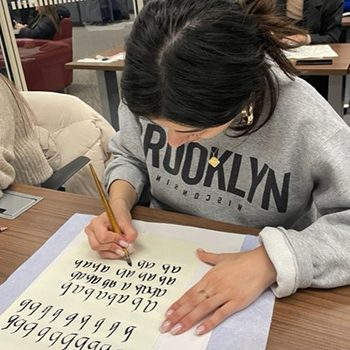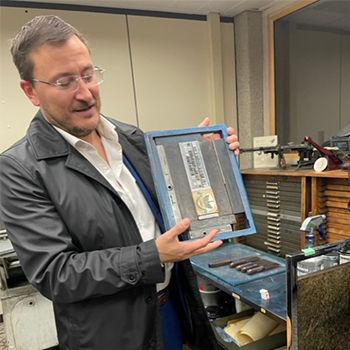Samia Tawwab, a professor of Italian studies, brought hands-on learning opportunities to students thanks to the Faculty of Liberal Arts & Professional Studies’ Experiential Education (EE) Fund.
This autumn, students enrolled in Media and the Idea of Italy (AP/IT3775 6.0) and The Italian Short Story (AP/IT 3371 3.0) embarked on a series of field trips that saw them studying traditional calligraphy techniques, printing by way of a replica Gutenberg press and undergoing operatic vocal training.
Media and the Idea of Italy examines the role of media in the development of the Italian language by investigating the impact of media on the standardization and dissemination of the language across time. A major turning point on this path is the evolution from manuscript to printed text culture heralded by the invention of Gutenberg printing press.
On Oct. 20, students of this course – together with Tawwab – attended “Be Bold, Be Italic: Hands on ‘La Operina,’ exploring Italian Calligraphy,” a workshop where participants were provided with quills, ink and paper and taught a centuries-old technique by Italian amanuenses, calligraphers from the Scriptorium Foroiuliense in San Daniele, Italy.
The students experienced the painstaking work of cancelleresca handwriting, the Papal Chancery’s calligraphy, now referred to as italic. This experience was integral in informing the students’ awareness of the arduous and costly process of manuscript copying, which limited the production of texts and access to reading, and to knowledge in general, to a small percentage of elites in Medieval Italian society. Within the course theme, considerable attention is dedicated to the continuous use of Latin in manuscript writing for centuries, a process that fostered a separation of two linguistic codes, written Latin and various spoken vernaculars within the region known as Italy today.

On Nov. 3, in collaboration with Tawwab and St. Michael’s College at the University of Toronto, Associate Professor Paolo Granata, Media and the Idea of Italy course coordinator, facilitated an in-person presentation which showed students models of movable characters of wood, metal, and modern 3D reproductions. He illustrated the process of creating a page with movable characters using a modern replica of the Gutenberg printing press. Granata then demonstrated how the constructed page would pass through an inking procedure before being hard-pressed between the press’ plates. Students noted how the laborious process required not only mastery of technique but also physical strength to operate the equipment.

“Along with the immense amount of manual labour you would have to use to press ink into the page, it took tremendous amounts of skill to put the moveable type together, as it would have to be put in backwards,” said Marcus Evangelista, an undergraduate student in Italian studies. “This is where the phrase ‘get your p’s and q’s together comes from’.”
The invention of the printing press played a central role in the development of the Italian language, underscoring the imperative to determine which of the many pre-existing vernaculars would have to undergo standardization to become the language of the printed text, as well as the language that would facilitate a political unification so aspired to by the intellectuals of the time. The Italian language has undertaken a uniquely slow process of development before it reached its national form. Even if the political unification of Italy was achieved in 1861, it was not until media, such as the newspaper, cinema, radio and television spread the standardized Italian language that Italian reached its current form.
The EE fund will also enable students to view a live performance of an Italian opera this winter. This essential Italian art form acted as a vehicle to spread the Italian language beyond its home country, as the de-facto language of opera.
Additional experiential learning initiatives benefitted students of The Italian Short Story thanks to the Istituto Italiano di Cultura and The Columbus Center, which fully funded the work of acclaimed Italian international theatre director Gianluca Barbadori. Students were able to participate in Barbadori’s professional voice training and performance storytelling workshops on Oct. 22. Barbadori later delivered a workshop, on Oct. 24, to the students of The Italian Short Story as well as those of intermediate and advanced Italian language courses, on Italian pronunciation, enunciation, intonation and voice projection in storytelling.
The Italian Studies program has plans to offer a course on Italian for professional purposes, a combination of training in different registers of Italian in the classroom and a community-based learning experience to enable students to master Italian in the workplace.
Originally published in YFile.
